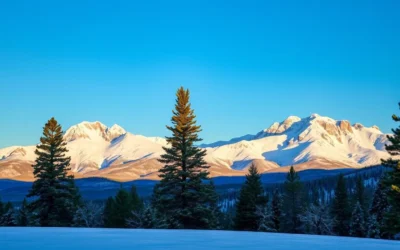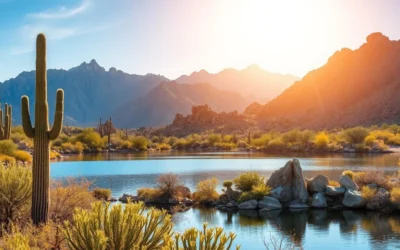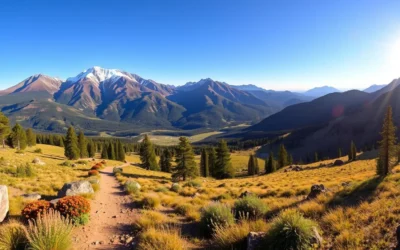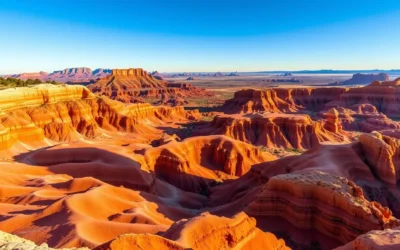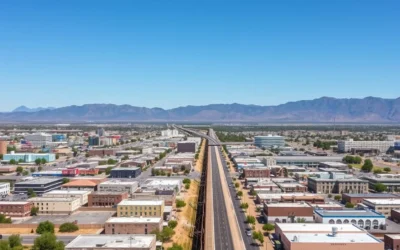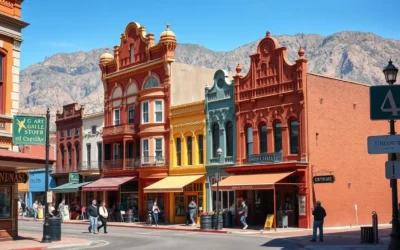✓ Accommodations ✓ Flights ✓ Rental Cars ✓ Tours & Activities
Nestled in northeastern Arizona, Petrified Forest National Park is a unique geological wonder that boasts one of the world’s largest and most colorful collections of petrified wood.
This stunning national park offers more than just petrified logs; it features the breathtaking Painted Desert, ancient petroglyphs, historic sites, and diverse hiking trails. With only about 520,000 visitors annually, it’s an ideal destination for those seeking an unspoiled natural experience.
You can explore the park’s main attractions in a single day, but its many wonders warrant a longer visit for those who want to delve deeper. This guide will cover the top attractions, best hiking trails, photography spots, and practical information to help you plan your trip.
Discovering Petrified Forest National Park
Located in northeastern Arizona, Petrified Forest National Park is a treasure trove of natural and historical significance. This unique national park is approximately 3 to 3.5 hours from both Phoenix and the Grand Canyon, making it an ideal stop on your Arizona road trip.

The park is divided into two distinct sections, connected by the 28-mile Petrified Forest Road. This main road starts at Interstate 40 in the north and ends at Highway 180 in the south. You can explore the park from north to south or vice versa, each direction offering a different perspective on the diverse landscapes.
- The northern section is home to the breathtaking Painted Desert, known for its vibrant, multicolored hills.
- The southern section boasts the highest concentration of petrified wood, a hallmark of the park.
- Beyond petrified wood, the park features diverse landscapes, including badlands, colorful mesas, ancient pueblo ruins, and petroglyphs.
- As the only national park containing a section of Historic Route 66, it holds significant historical importance.
Whether you’re a history buff, a geology enthusiast, or simply looking for a unique adventure, Petrified Forest National Park has something to offer. With its rich history, stunning landscapes, and diverse wildlife, it’s one of the best area parks to visit in the United States.
What is Petrified Wood?
The process of petrification transforms wood into a stunning stone, a phenomenon that is beautifully exemplified in Petrified Forest National Park. The fallen, petrified trees that give this national park its name date back to 225 million years ago when the area was near the equator on the supercontinent of Pangaea.
As these ancient trees fell, they were buried in river channels. The mineral-rich river water saturated the trees, slowly replacing the organic material with quartz crystals over millions of years. This process preserved the trees, allowing us to see the rings and bark patterns, now composed of colorful quartz crystals.

Tectonic movements 60 million years ago lifted the Colorado Plateau, causing erosion that eventually revealed these petrified trees. Iron, manganese, and carbon add color to the petrified wood, creating a kaleidoscope of hues.
| Characteristics | Description |
|---|---|
| Formation Process | Replacement of organic material with quartz crystals |
| Age | 225 million years old |
| Colors | Created by iron, manganese, and carbon |
These petrified logs provide valuable information about prehistoric ecosystems and climate conditions. It’s essential to preserve this natural wonder; visitors should never remove petrified wood from the park, as an estimated 12 tons are illegally taken each year.
Planning Your Visit to Petrified Forest National Park

Before you head to Petrified Forest National Park, it’s essential to plan your visit to make the most of your trip. The park is not open 24 hours a day, and it’s crucial to know the operating hours to avoid any inconvenience.
The Petrified Forest National Park hours vary by season, but for most of the year, the park opens at 8 am and closes at 5 pm. You can find the most updated hours of operation on the official park website. The entrance fee is $25 per vehicle for a 7-day pass, or you can use your National Parks Pass for free.
It’s also important to note that the park observes Mountain Standard Time year-round and does not observe daylight savings time. This can be confusing for visitors from other regions, so be sure to adjust your clocks accordingly. The best times to visit are during the spring and fall when temperatures are pleasant. Summer can be quite hot, with temperatures ranging from 90-100°F, and there’s a chance of monsoon thunderstorms from July through September.
If you’re planning to drive to Petrified Forest National Park, here are some helpful driving distances and times from nearby destinations: Phoenix (212 miles, 3.5 hours), Flagstaff (115 miles, 1.75 hours), Grand Canyon (200 miles, 3 hours), and Monument Valley (192 miles, 3.25 hours). Since dining options are limited to the Painted Desert Diner near the north entrance, which is open from 9 am to 5 pm, it’s recommended to bring your own food and water.
By planning your visit in advance, you can ensure a smooth and enjoyable trip to this incredible national park.
Exploring the Painted Desert (North Section)
As you enter the northern section of Petrified Forest National Park, you’re greeted by the breathtaking vistas of the Painted Desert. Your journey begins at the Painted Desert Visitor Center, where you can gather maps, information, and insights into the park’s geology and history through the exhibits.
From the visitor center, take a short drive to the start of the Painted Desert Rim Trail, a relatively flat 1-mile out-and-back trail that offers spectacular views of the colorful badlands. The trail runs from Tawa Point to Kachina Point and passes by the historic Painted Desert Inn. If you’re short on time or prefer not to walk, driving to these viewpoints is a convenient alternative.

The northern drive is dotted with numerous viewpoints, including Tiponi, Tawa, Kachina, Chinde, Pintado, Nizhoni, and Whipple Points. Each of these viewpoints offers a unique perspective on the multicolored landscape, making them must-visit spots. The Painted Desert Inn, a National Historic Landmark, is another highlight. Once a hotel and restaurant, it now serves as a museum about Route 66, complete with an ice cream parlor.
| Viewpoint | Description | Distance from Visitor Center |
|---|---|---|
| Tawa Point | Panoramic views of the Painted Desert | 1 mile |
| Kachina Point | Scenic overlook of the badlands | 1.5 miles |
| Painted Desert Inn | Historic inn with Route 66 museum | 2 miles |
The Painted Desert gets its name from the vibrant bands of red, pink, orange, and lavender colors visible in the badlands. These colors are a result of different mineral deposits in the sedimentary layers. Be sure to stop by the Route 66 exhibit, featuring a vintage Studebaker and remnants of the historic highway, making Petrified Forest National Park the only national park with a section of Route 66.
Historic Sites in Petrified Forest National Park
Petrified Forest National Park is not just a natural wonder, but also a treasure trove of historic sites waiting to be discovered. As you explore the park, you’ll come across numerous landmarks that highlight its rich cultural and historical significance.
One of the park’s most notable historic sites is thePainted Desert Inn, a National Historic Landmark that dates back over 100 years. This former hotel and restaurant now serves as a museum about Route 66, offering a glimpse into the park’s past. The inn is an exemplary model of Pueblo Revival architecture, crafted by the Civilian Conservation Corps (CCC) in the 1930s, and features murals by the renowned Hopi artist Fred Kabotie.
As you visit the Painted Desert Inn, you’ll also have the opportunity to explore the adjacentRoute 66 exhibit. Here, you can see a vintage Studebaker automobile, the old roadbed of Route 66, and a line of historic telephone poles that mark the path of this iconic American highway. This exhibit is a fascinating look at the history of automobile tourism in the United States.
The park’s historic sites provide more than just a glimpse into the past; they offer context for understanding how human interaction with this landscape has evolved over time. From prehistoric times to the early days of automobile tourism, Petrified Forest National Park preserves not just natural wonders but also human history.
Some of the key historic sites to explore include:
- The Painted Desert Inn, a National Historic Landmark and museum about Route 66.
- The Route 66 exhibit, featuring a vintage Studebaker and historic telephone poles.
- The old roadbed of Route 66, a testament to the park’s role in America’s transportation history.
These sites are easily accessible from the main park road and offer excellent opportunities for photography and learning. As you explore these historic sites, you’ll gain a deeper appreciation for the park’s cultural and historical significance.

By visiting these historic sites, you’ll experience the rich history preserved within Petrified Forest National Park, making your visit even more memorable.
Ancient Puebloan Sites
The Ancient Puebloan Sites within Petrified Forest National Park provide a captivating look into the region’s rich cultural history. You can explore the fascinating Puerco Pueblo archaeological site, where approximately 200 Ancestral Puebloan people built a 100-room village over 700 years ago. The foundations of their buildings are still visible today.
A short, easy 0.3-miletrailloops through the Puerco Pueblo ruins, allowing you to see the remnants of this once-thriving community. Interpretive signs along the way provide insights into the daily lives of the Pueblo people. This site is easily accessible from the car park, making it suitable for visitors of all ages and abilities.
Just down the road from Puerco Pueblo isNewspaper Rock, a site featuring over 600petroglyphscarved by the Puebloan people. These ancient images can be viewed from a designatedtrailand overlook, though visitors are not permitted to leave thetrailfor a closer look to ensure the preservation of these delicate artworks. Thepetroglyphsat Newspaper Rock are a significant form of communication and artistic expression, with some dating back as far as 2,000 years.
These archaeological sites, including Puerco Pueblo and Newspaper Rock, are spread across theareaand provide evidence of the sophisticated cultures that thrived in this environment for centuries. Spanning severalmiles, these sites offer a glimpse into the lives of the people who lived here long ago. You can explore these sites, which are easily accessible from the main park road and require minimal hiking, making them perfect for a day trip of about 2milesof walking.

Visiting these Ancient Puebloan Sites is a great way to connect with the human history of the region. By exploring Puerco Pueblo and Newspaper Rock, you can gain a deeper understanding of the lives and cultures of the people who lived in thisareacenturies ago.
The Tepees and Blue Mesa Area

As you explore Petrified Forest National Park, you’ll encounter the breathtaking Tepees and Blue Mesa area. The main park road, Petrified Forest Road, winds through the dramatically striped, cone-shaped hills of the Tepees, creating a visually stunning experience.
The Blue Mesa Scenic Drive, a 3.5-mile detour road, offers several spectacular viewpoints overlooking the uniquely colored badlands. The distinctive blue-gray hues of this area are created by bentonite clay, adding to the natural beauty of the landscape.
The Blue Mesa Trail is a 1-mile paved loop that descends into the heart of the badlands, allowing visitors to walk among the striped hills and scattered pieces of petrified wood. This trail is very popular and is considered one of the best things to do in the park.
For those seeking a more secluded experience, the Blue Forest Trail offers a 3-mile round trip hike through similar terrain with fewer crowds. The varied terrain and potential for more rewarding views make this trail an attractive option for hikers.
The vibrant colors in this area, including blue, pink, purple, and gray, come from different minerals in the Chinle Formation, deposited during the Late Triassic period. This geological history makes the Tepees and Blue Mesa area not only visually striking but also rich in natural history.
This area is highly photogenic, especially during the morning or late afternoon when the colors are most vibrant and the shadows create dramatic contrasts on the striped hills. Visitors are encouraged to take their time and enjoy the scenery.
Petrified Forest National Park: Best Things to Do in the Southern Section
As you explore the southern section of Petrified Forest National Park, you’ll discover some of the park’s most breathtaking attractions. This area is renowned for its high concentration of petrified wood, making it a must-visit destination for anyone interested in geological wonders.
The southern section is home to several key attractions, including the Jasper Forest Overlook, which provides stunning views of one of the largest collections of petrified wood in the park. From this viewpoint, you can also access the Jasper Forest Trail, a 2.4-mile hike that offers a more secluded experience for those willing to venture off the beaten path.

Another highlight of the southern section is the Crystal Forest Trail, an easy 0.8-mile loop that takes you through a vibrant landscape of colorful petrified logs. This trail is perfect for families or those looking for a leisurely walk amidst nature’s splendor.
- Explore the Agate Bridge, a 110-foot petrified log that spans a small ravine, showcasing the impressive size of these prehistoric trees.
- Discover the southern section’s unique geological features, including the presence of quartz crystals in a range of colors, from reds and oranges to purples and blues.
- Remember to stay on designated trails and respect the park’s natural resources by not removing any petrified wood or other materials.
The southern section of Petrified Forest National Park offers an unforgettable experience, with its rich geological history and stunning landscapes. By following the guidelines and respecting the park’s rules, you can enjoy a safe and enriching visit to this incredible destination.
Best Hiking Trails in Petrified Forest National Park

From easy strolls to more challenging hikes, Petrified Forest National Park has something for every kind of hiker. The park is home to a variety of trails that showcase its unique geological features and natural beauty.
The Giant Logs Trail is a short, 0.4-mile loop located behind the Rainbow Forest Museum. This trail takes you through some of the largest petrified logs in the park, including the massive “Old Faithful” log. You can walk the entire loop or head straight to the enormous log lying on its side, a popular spot for photos.
The Long Logs Trail is another popular option, featuring a 1.6-mile loop that takes you around a field containing some of the longest petrified trees in the park. You can combine this trail with the Agate House Trail for a longer hike, totaling approximately 3.25 miles and requiring about 1.5 hours to complete.
The Agate House Trail is a 2-mile round trip that leads to a reconstructed seven-room pueblo built with petrified wood by ancestral Puebloan people around 700 years ago. This trail offers a glimpse into the park’s rich cultural history.
For those seeking more solitude, the Blue Forest Trail (3 miles) and Jasper Forest Trail (2.4 miles) offer unique perspectives of the park’s landscapes. Additionally, the park provides backcountry hiking and camping opportunities in designated wilderness areas for more adventurous hikers, though these require permits and proper preparation for the desert environment.
Whether you’re looking for a leisurely walk or a more challenging hike, Petrified Forest National Park’s diverse trails ensure an unforgettable experience amidst its breathtaking natural beauty.
Photography Tips and Best Viewpoints
To make the most of your photography experience in Petrified Forest National Park, it’s essential to know the best viewpoints and times for capturing its breathtaking beauty. The Painted Desert overlooks are particularly stunning during early morning or late afternoon when the low-angle sunlight enhances the vibrant colors of the badlands.
The Blue Mesa area is another photogenic hotspot, with its purple and blue hues contrasting beautifully with scattered pieces of petrified wood. Driving the Blue Mesa Scenic Road offers wonderful viewpoints, with one of the best just past the car park for the Blue Mesa Trail.

For capturing expansive vistas, consider using a wide-angle lens, and don’t forget a polarizing filter to enhance the sky and reduce glare. Look for close-up details of petrified wood, especially in the Crystal Forest and Giant Logs areas, to showcase their crystalline structures and vibrant colors.
One of the advantages of photographing in Petrified Forest National Park is its relatively low visitation, allowing photographers to often find solitude and unobstructed views, especially during shoulder seasons.
Where to Stay Near Petrified Forest National Park

If you’re heading to Petrified Forest National Park, you’ll find that Holbrook, Arizona, is the most convenient place to stay, with various hotels and motels to choose from.
Although there are no lodging options within Petrified Forest National Park itself, you can camp within the park boundaries with a free permit obtained from either visitor center. Holbrook, about 20 minutes from the south entrance, offers a range of accommodation options from budget-friendly chain hotels to historic Route 66 motels.
For a unique experience, consider the Wigwam Motel in Holbrook, famous for its concrete tepees that inspired the Cozy Cone Motel in the Disney-Pixar movie “Cars.” For families, the La Quinta Inn & Suites is recommended for its modern amenities and good reviews. If reliable Wi-Fi is a priority, Days Inn is a solid choice. For a taste of Route 66 history, Brad’s Desert Inn is a great option.
If Holbrook is fully booked, consider staying in Winslow (about 60 minutes west) or Gallup, New Mexico (about 90 minutes east), both of which offer additional lodging options along Interstate 40.
Conclusion: Making the Most of Your Visit
Visiting Petrified Forest National Park can be a day-long adventure, but with the right plan, you can enjoy its many wonders. To make the most of your visit, start early, especially during the hot summer months. A north-to-south route is recommended, beginning with the breathtaking Painted Desert and ending with the vast concentrations of petrified wood in the southern section.
While one day is enough to see the main highlights, taking your time to explore less-traveled areas will reward you with solitude and stunning landscapes. Remember to respect the park by staying on designated trails and preserving the natural treasures for future generations.
The above is subject to change.
Check back often to TRAVEL.COM for the latest travel tips and deals.

